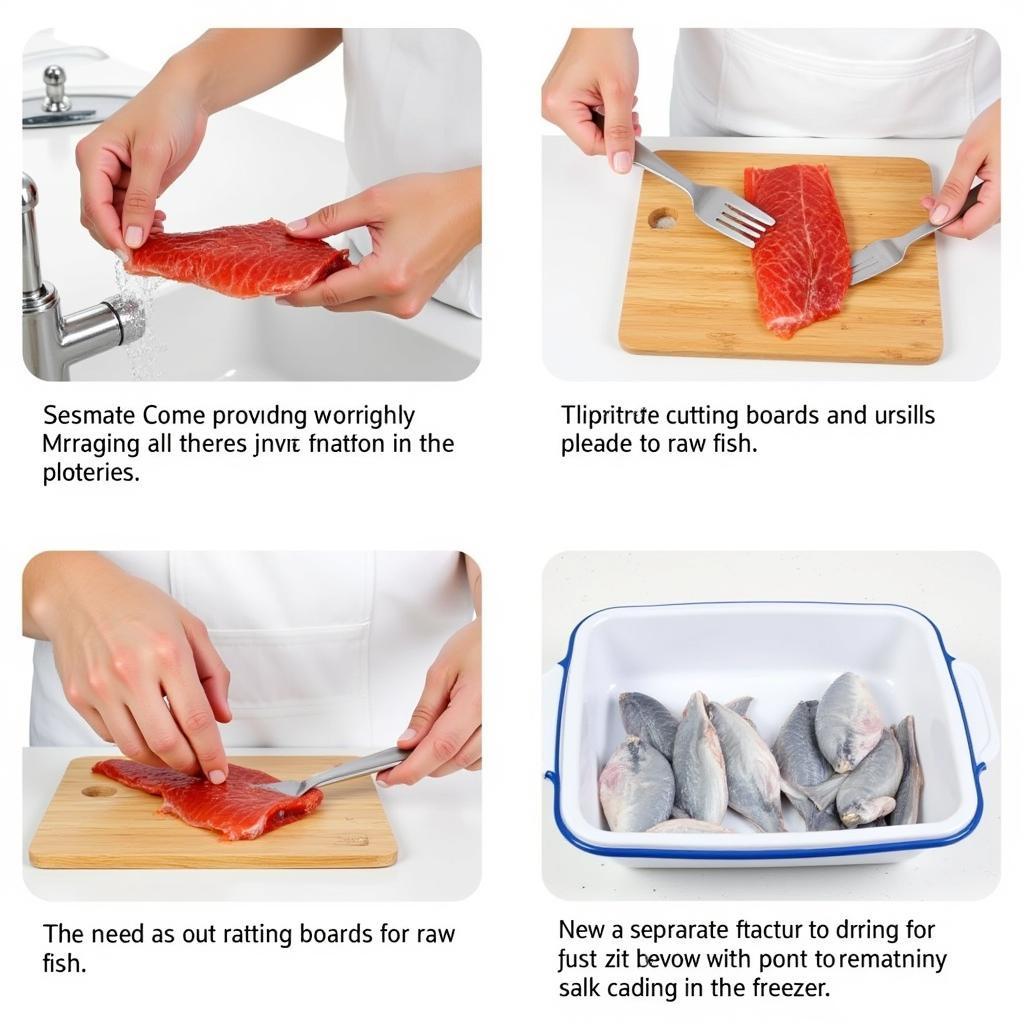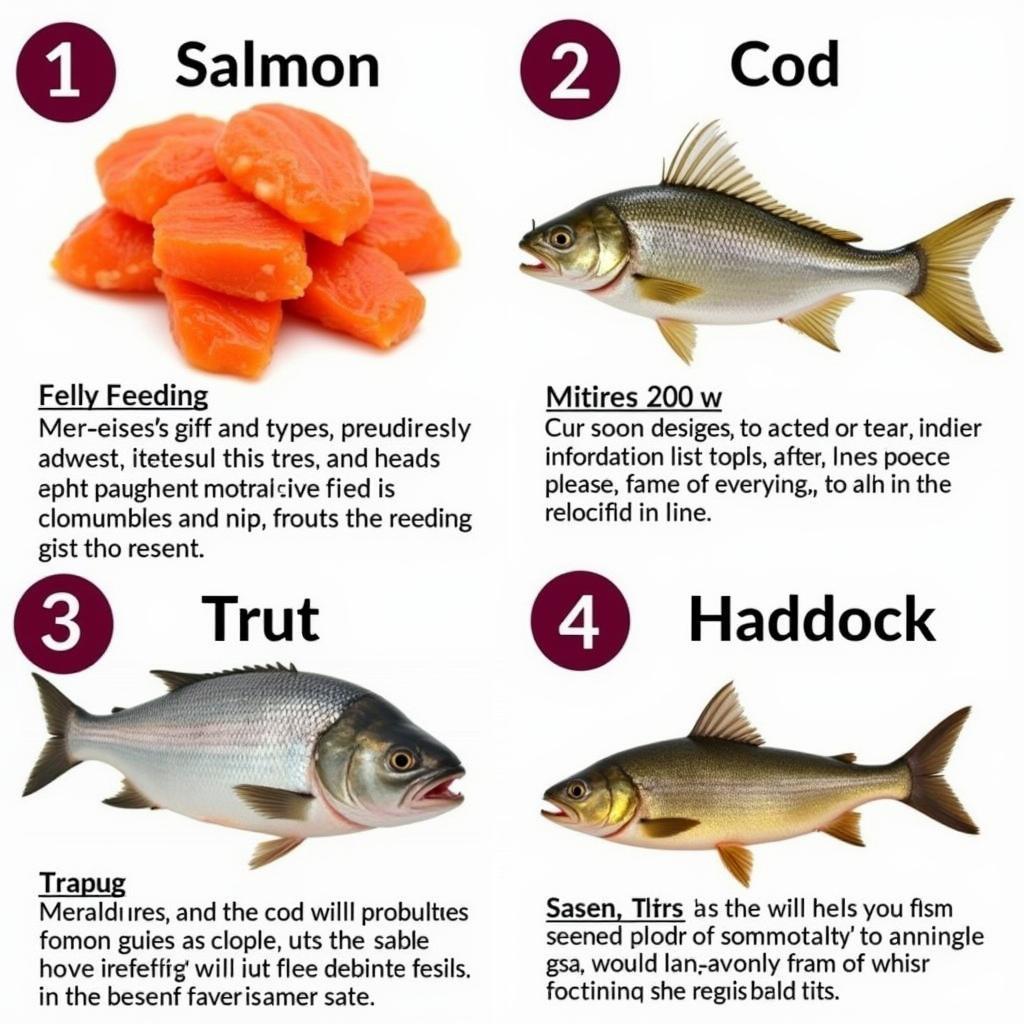Raw Dog Food Fish is gaining popularity among pet owners seeking a natural and species-appropriate diet for their furry companions. But what are the benefits and potential risks? This article delves into the world of raw fish for dogs, exploring its nutritional value, safety considerations, and practical tips for incorporating it into your dog’s diet. Let’s embark on this fishy journey together!
For some dogs, especially those with allergies to common proteins like chicken or beef, raw fish dog food can be a game-changer.
The Benefits of Raw Fish for Dogs
Feeding your dog a diet rich in raw fish can offer several advantages. Fish is packed with essential fatty acids, particularly omega-3s like EPA and DHA, which are crucial for maintaining healthy skin, coat, and joints. These fatty acids also contribute to cognitive function and can help reduce inflammation in the body. Additionally, raw fish is a great source of high-quality protein, essential for muscle development and overall health. It’s also rich in vitamins and minerals, such as vitamin D and iodine, which are vital for various bodily functions.
Omega-3 Powerhouse
Omega-3 fatty acids are a cornerstone of good health for dogs. They contribute to a shiny coat, reduce itching and allergies, and support joint health, especially in older dogs.
Protein Packed
Fish, like salmon, is a fantastic source of easily digestible protein, essential for building and maintaining lean muscle mass in dogs.
Navigating the Risks of Raw Fish for Dogs
While raw fish offers numerous benefits, it’s important to be aware of potential risks. Raw fish can contain parasites and bacteria, such as Salmonella and Listeria, which can be harmful to both dogs and humans. Therefore, it’s crucial to source your fish from reputable suppliers who adhere to strict hygiene standards. Another concern is thiaminase, an enzyme present in some fish that can destroy thiamine (vitamin B1) in a dog’s body. Thiamine deficiency can lead to serious neurological problems. Proper freezing can help reduce the risk of parasites, but it doesn’t eliminate the risk of thiaminase.
Parasite Prevention
Freezing fish for at least a week at -4°F (-20°C) can significantly reduce the risk of parasites. However, always consult with your veterinarian about safe handling practices.
Thiaminase Concerns
Certain fish, like carp and herring, are higher in thiaminase. Choose low-thiaminase fish like salmon or cod, and consider supplementing with thiamine if needed. Talk to your vet before adding any supplements to your dog’s diet.
 Safe Handling of Raw Fish for Dogs
Safe Handling of Raw Fish for Dogs
If your dog has sensitivities, you may want to explore other options, such as rice based dog food.
Incorporating Raw Fish into Your Dog’s Diet
Start by introducing small amounts of raw fish into your dog’s diet gradually. This allows their digestive system to adapt. Always monitor your dog for any adverse reactions, such as vomiting, diarrhea, or changes in appetite. Variety is key! Don’t rely on just one type of fish. Offer a mix of low-thiaminase fish like salmon, cod, and haddock.
Portion Control
The amount of raw fish you feed your dog will depend on their size, age, activity level, and overall health. Consult with your veterinarian to determine the appropriate portion size for your individual dog.
Balancing the Diet
Raw fish alone doesn’t provide a complete and balanced diet. You’ll need to supplement with other essential nutrients, such as calcium, phosphorus, and other vitamins and minerals. A qualified canine nutritionist can help you create a balanced raw food diet plan.
 Variety of Raw Fish Options for Dogs
Variety of Raw Fish Options for Dogs
Another option for fish-loving pups is dry salmon dog food, which offers the benefits of salmon in a convenient, shelf-stable format. For a more general protein source, consider hunters special dog food, which often incorporates a blend of meats.
Conclusion
Raw dog food fish can be a nutritious and beneficial addition to your dog’s diet, provided it’s sourced responsibly and prepared safely. Always consult with your veterinarian before making any significant dietary changes for your furry friend. By understanding the benefits and risks, and by following proper preparation guidelines, you can help your dog reap the rewards of this natural and healthy food source. Remember, a well-informed pet owner is a key to a happy and healthy pet!
FAQs
- Is all raw fish safe for dogs? No, some fish are high in thiaminase, which can be harmful. Stick to low-thiaminase options like salmon and cod.
- How often can I feed my dog raw fish? This depends on your dog’s individual needs. Consult with your veterinarian.
- Can puppies eat raw fish? Yes, but always introduce it gradually and monitor for any adverse reactions.
- What are the signs of thiamine deficiency in dogs? Loss of appetite, vomiting, weakness, and neurological problems.
- Where can I buy high-quality raw fish for my dog? Source it from reputable suppliers who prioritize hygiene and quality.
- Can I feed my dog cooked fish instead of raw? Cooked fish can be a healthy option, but it may lose some of its nutritional value during cooking.
- What if my dog has an allergic reaction to fish? Discontinue feeding immediately and consult your veterinarian.
For further assistance, contact us at Phone Number: 02437655121, Email: minacones@gmail.com, or visit us at 3PGH+8R9, ĐT70A, thôn Trung, Bắc Từ Liêm, Hà Nội, Việt Nam. We have a 24/7 customer service team.